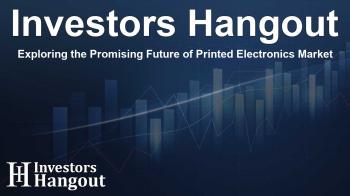Exploring the Promising Future of Printed Electronics Market

Significant Growth in the Printed Electronics Market
According to a recent analysis, the global Printed Electronics market is on a remarkable growth trajectory. With the increasing adoption of printed electronics across various sectors like automotive, consumer electronics, and healthcare, the market is expected to surge to an impressive USD 60.18 billion, showcasing a compound annual growth rate (CAGR) of 19.78% between now and the end of the decade.
Transformative Technologies Driving Market Demand
The rapid advancement in technology is a key driver in this sector. Devices such as IoT gadgets, smartphones, and communication systems are increasingly integrating printed electronics. This technology not only enhances functionality but also reduces manufacturing costs and allows for innovative design flexibility. Such advancements present a broad range of opportunities for market expansion in the years to come.
Growing Consumer Electronics Sector
As consumer electronics evolve to be more compact and feature-rich, the demand for flexibility and affordability in electronic components becomes more pronounced. Printed electronics enable the creation of thin, lightweight, and flexible circuits on various substrates through cost-efficient printing methods. This innovation is crucial for applications in wearables, foldable technologies, and smart packaging, where traditional rigid components are inadequate.
Innovative Developments from Key Players
Prominent market players are actively enhancing their product lines and pioneering new technologies. For example, Naxnova Technologies has established an R&D center focused on flexible printed electronics, aiming to develop advanced sensors and circuits applicable across industries including automotive and medical wearables. In a similar vein, Henkel recently unveiled innovations at a major trade show, spotlighting advancements in smart surfaces and healthcare connectivity, contributing to the market's growth.
Rising Adoption in Wearable Healthcare Technology
As the focus on personalized medicine and remote health monitoring intensifies, printed electronics stand to play a pivotal role in wearable healthcare devices. With printed sensors and flexible circuits, these wearables can monitor crucial health metrics like heart rate and temperature in real-time. This trend aligns with the growing popularity of telehealth services, especially amidst aging populations.
Partnerships Enhancing Innovation
Collaboration among major firms is vital to advancing printed electronics in healthcare. Recently, Henkel, Covestro, and Quad Industries collaborated to expedite the development of innovative wearables, combining their diverse expertise to foster new printed electronics solutions, particularly for healthcare applications.
Regional Market Dynamics
The printed electronics market displays varying growth dynamics globally. North America leads innovation, particularly in healthcare and aerospace, while Europe emphasizes sustainability through advanced applications. The Asia-Pacific region is poised for rapid growth, buoyed by extensive consumer electronics manufacturing and supportive government programs across nations like China, Japan, and India.
Market Segmentation Insights
The printed electronics market can be analyzed through several key segments. The material segment encompasses inks and substrates, while technology classifications include inkjet and screen printing among others. Furthermore, the application spectrum spans displays, photovoltaic solutions, RFID, and more, catering to diverse market needs.
Competitive Strategies in a Growing Market
Several leading companies dominate the printed electronics market landscape, including major names like BASF, DuPont, and Samsung Electronics. Their ongoing research and product development efforts play a significant role in shaping the market's future trends and innovations.
Concluding Thoughts
The outlook for the printed electronics market is overwhelmingly positive, driven by the surging demand for lightweight and cost-efficient components. This burgeoning segment is transforming industries through innovative applications, particularly in healthcare wearables—where the versatility and affordability of printed electronics are key to developing next-generation devices.
Frequently Asked Questions
1. What is driving growth in the printed electronics market?
The printed electronics market is primarily driven by technological advancements and the increasing demand for lightweight, flexible, and affordable components in various applications.
2. Which sectors are benefiting from printed electronics?
Key sectors benefiting from printed electronics include automotive, consumer electronics, and healthcare, especially in the development of wearables and IoT devices.
3. How is the consumer electronics sector evolving?
The consumer electronics sector is evolving towards smaller, portable, and feature-rich devices that require flexible, cost-effective electronic components, heavily reliant on printed electronics.
4. What role do partnerships play in advancing printed electronics?
Partnerships among industry leaders facilitate the sharing of expertise and resources, accelerating the development and adoption of innovative solutions in printed electronics.
5. What regions are leading in the printed electronics market?
North America, Europe, and Asia-Pacific are critical regions in the printed electronics market, each contributing growth through innovation, sustainability, and manufacturing capabilities.
About The Author
Contact Dylan Bailey privately here. Or send an email with ATTN: Dylan Bailey as the subject to contact@investorshangout.com.
About Investors Hangout
Investors Hangout is a leading online stock forum for financial discussion and learning, offering a wide range of free tools and resources. It draws in traders of all levels, who exchange market knowledge, investigate trading tactics, and keep an eye on industry developments in real time. Featuring financial articles, stock message boards, quotes, charts, company profiles, and live news updates. Through cooperative learning and a wealth of informational resources, it helps users from novices creating their first portfolios to experts honing their techniques. Join Investors Hangout today: https://investorshangout.com/
The content of this article is based on factual, publicly available information and does not represent legal, financial, or investment advice. Investors Hangout does not offer financial advice, and the author is not a licensed financial advisor. Consult a qualified advisor before making any financial or investment decisions based on this article. This article should not be considered advice to purchase, sell, or hold any securities or other investments. If any of the material provided here is inaccurate, please contact us for corrections.

